Pros
– Unparalleled performance
– Brilliant set of cameras
– Exquisite Display
– Understated, but premium design
– The way it feels in the hand
– Speakers
– Long software update commitment
– Battery life
Cons
– 25W wired charging, with no charging brick in the box
Price: Rs 95,999 for the 8GB + 256GB variant
Rating: 4.75/5
The Samsung Galaxy S23 is one of the best compact smartphones in the market. Having said that, it packs a punch that would stun even its elder siblings, the Galaxy S23 Plus and even the mighty Galaxy S23 Ultra. In fact, there are certain areas in which the petite Galaxy S23 is actually better than both of its elder siblings.
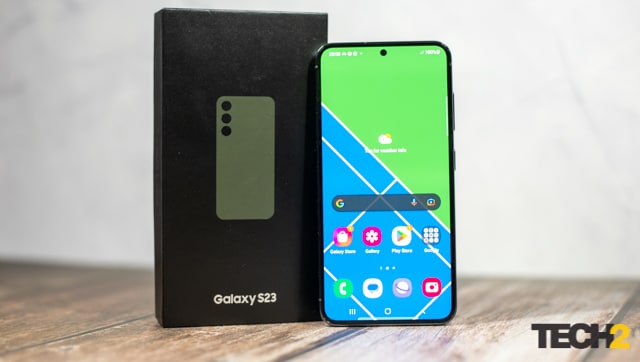
What really stood out was the display and the cameras. Barring the design of the rear panel, there are not a lot of new or revolutionary aspects of the Samsung Galaxy S23. However, the finetuning that Samsung has done for the Galaxy S23, and the attention it has given to tiny, little things is what makes the device so praise-worthy.
I am just going to say it out loud – this is as good a smartphone can get in 2023, especially if you’re in the market looking for one that is compact and easy to yield. The Galaxy S23 is so much more than a mere spec update over the Galaxy S22 from last year – this one is in a league of its own.
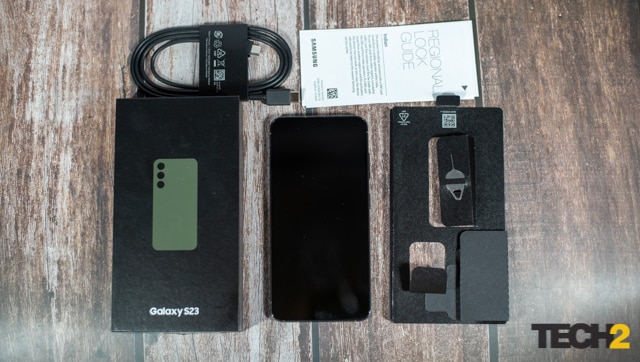
Samsung Galaxy S23 review: The design
Like its elder sibling, the Galaxy S23 Ultra, the Galaxy S23 looks a lot more premium than most of the smartphones that masquerade as premium smartphones using some trick or the other. The difference, again, between the S23 and all those other premium smartphones is that the Galaxy S23 looks premium because it is premium.
The Galaxy S23 is a very beautiful device to look at, and an even more beautiful device to hold, thanks to its more compact size. It isn’t as humongous as most of your other smartphones, the Galaxy S23 Ultra included, but the way the device feels in your hand, the ease with which one is able to operate it using just one hand is pretty commendable.
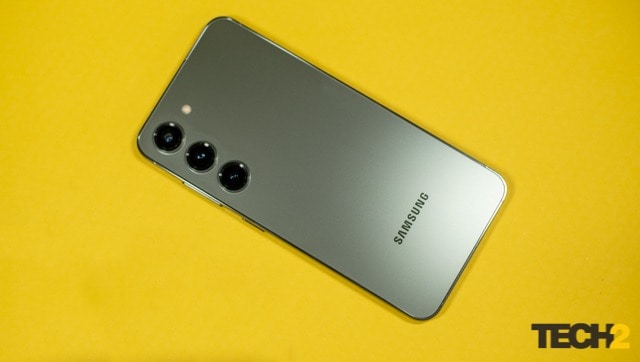
This also makes the Galaxy S23 much more pocketable and user-friendly than most gigantic premium smartphones of today. And yes, just like the S23 Ultra, the Galaxy S22 is built like a tank and has a ton of premium-feeling material on the outside.
Compared to last year, Samsung decided to go for a cleaner design for their entry-level S series device this year – while the S22 had a discernible camera housing, the S23 does not – instead, it has a cleaner, flat back design, in which the rear cameras and flash just float. The cameras are surrounded by a metallic ring on all of the glass elements, just like it did in the S23 Ultra.
Our test device was a dark green unit, which looked particularly stunning, thanks to its matte finish. Other than green, you get a ton of other colour options as well – phantom black, cream, green, lavender, graphite and lime.
The 6.1-inch 1080p AMOLED screen on the front is the same as on the Galaxy S22, but with enhanced brightness. The front of the S23 is identical to the S22, right down to the amazingly small screen bezels and camera cutout. This time around, you get Gorilla Glass Victus 2 panels on both, the front and the back. The panels on the S23 are flat, as opposed to the slight curvature that the S23 Ultra gets.
The aluminium frame also has flatter edgers, although, they have a very slight curvature, which helps it blend into the front and back panels. This not only gives the device a very premium hand feel but also makes gripping the S23 a lot easier and more comfortable.
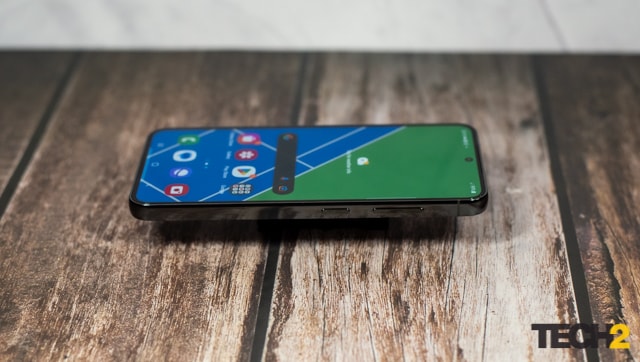
The button placement on all three S23 models is the same, so on the right, we get to see the volume rockers, as well as the power button. Despite the device’s smaller size, the power button and the volume rockers are of the same size as the S23 Ultra and have been spaced out a little, because of which it is easy to distinguish between the two very easily.
At the bottom, we get a familiar view – a speaker grille for one of the speakers, a USB Type-C port, and the SIM tray, of course with the exception of the S-Pen.
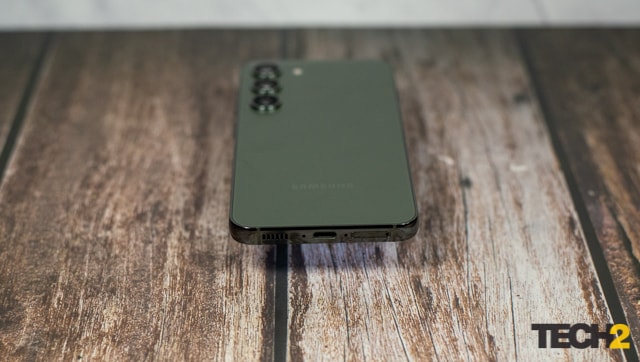
Samsung’s push for sustainability is visible in the Galaxy S23 as well. Just like the S23 Ultra, the rear and front panels use a ton of recycled materials, such as recycled glass and plastic, whereas the aluminium frame is also made of recycled aluminium.
Samsung Galaxy S23 review: The display
The S23 Ultra has one of the best displays in a smartphone this year. The new Galaxy S23 features the same 6.1-inch Dynamic AMOLED 2X display as the Galaxy S22. However, there’s one major improvement – it has 35 per cent greater peak brightness, which exponentially improves the experience of watching anything in HDR. And thanks to support for Widevine L1, stream apps can stream at 1080p in HDR10 without any hassle.
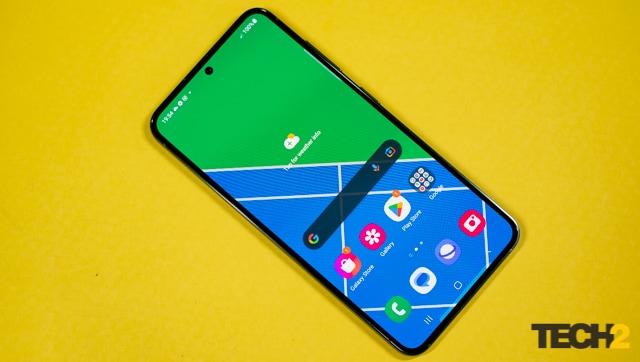
The AMOLED display has a resolution of 2340 x 1080 pixels. However, because this is a smaller screen, at 6.1-inches, it has a much better pixel density. As a result, everything that you watch on this screen is tack sharp and crisp, comparable to the S23 Ultra. We also get support for a dynamic refresh rate of 120Hz, a broad colour gamut, and HDR10+. The panel also supports a peak brightness of 1750 nits.
The colours from the panel are, rich, and super-contrasty, and beautifully saturated. The images are sharp and crisp. Even under direct sunlight, we had no issues whatsoever in reading off of the screen and viewing content.
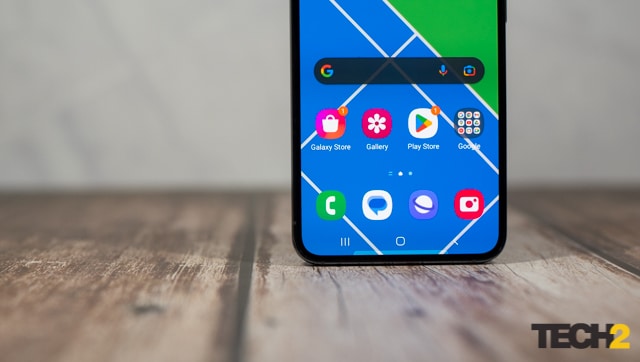
What makes the display stand out is the Vivid or the wide colour gamut mode. The inclusion of a new Advanced Vision Booster which automatically adjusts the screen for maximum colour accuracy and contrast in low-light environments is a nice touch
Samsung Galaxy S23 review: The camera
The cameras on the Galaxy S23 are nearly identical to those on the Galaxy S22. We get a 50MP sensor (Samsung S5KGN3 sensor) for the primary camera, a 12MP sensor (Sony IMX564) for the ultra-wide camera and a 10MP sensor (Samsung S5K3K1 sensor) with a 3X telephoto lens on the back, and a 12MP sensor for the front-facing camera.
The 50MP main sensor comes with dual-pixel PDAF and OIS. The 10MP telephoto camera also uses PDAF and OIS. The front-facing 12MP selfie camera also uses dual-pixel PDAF.
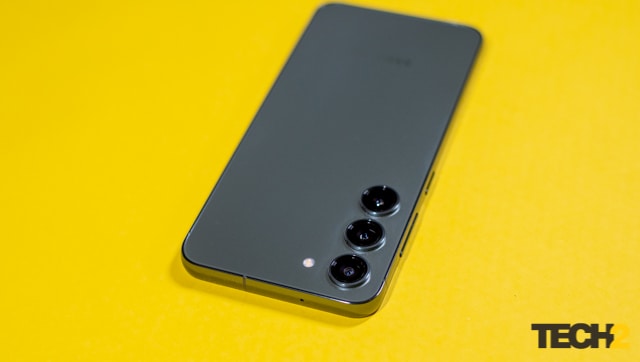
By default, the 50MP sensor shoots 12MP binned photos for. The photographs it captures are simply amazing. You can also use the 50MP sensor to click 50MP RAW photos, and get a bit of astrophotography done using the Exper RAW mode. Yes, we get that setting in the main camera app itself and don’t need to download an app separately.
The main 50MP sensor produces some seriously aesthetic photographs full of vivid colours, and good and sharp contrast. The photos have a broad dynamic range especially when the lighting is spot on. The images have a slightly warm tone, and punchier colours, which, may throw off some people, who like to edit their photos in their own way. For a majority of people though, the pictures are social media ready, straight out of the camera.
Switching to the 12MP ultra-wide sensor means you give up some detail and brightness, but nonetheless the images are pretty sharp. The Portrait Mode, which uses the 10MP telephoto lens, captures beautiful portrait images with some nice and creamy bokeh and has precise edge recognition and details.
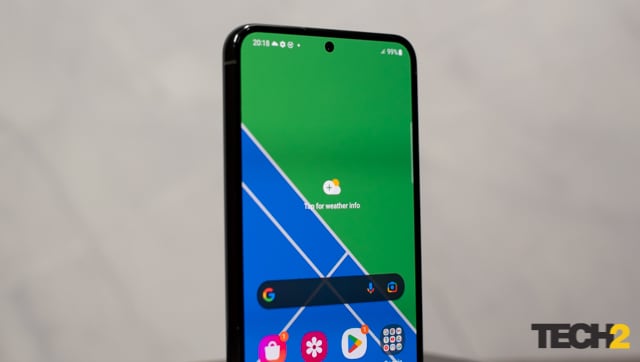
The night mode works really and shots taken in low light have plenty of detail. Yes, there’s some noise, but overall, users will be pretty pleased with what the S23 is capable in terrible lighting conditions.
As for the zooming capabilities, they are legendary. You don’t get the 100X zoom with the S23 as you did with the S23 Ultra, but the 30X zoom that the S23 gets is at par with the S23 Ultra – it has plenty of details and the images are more than good enough.
In well-lit conditions, the 12MP selfie camera captures decent detail and colours, albeit some flattening of face features is visible. The HDR is again, pretty awesome. The portrait mode on the front-facing camera, is again, exquisite.
As far as video recording is concerned, the S23 can record at 8K resolution up to 30 frames per second. The Galaxy S23’s footage has accurate colour tones and very crisp images. Video stabilization has also improved on the Galaxy S23 compared to the Galaxy S22.
For some unedited, raw photos taken using the Galaxy S23, click here.
Samsung Galaxy S23 review: The performance, software experience and UI
The Galaxy S23 is the fastest Android smartphone on the market, and sometimes, even faster than its elder sibling, the Galaxy S23 Ultra. That’s what at least some of the benchmarks that we tested say.
The Samsung Galaxy S23 is powered by the same custom overclocked Snapdragon 8 Gen 2 chipset that powers the S23 Ultra, so the performance of the Galaxy S23 is at par with its elder sibling.
Our test unit came with 8GB of LPDDR5X RAM and 256GB of UFS 4.0 internal storage. The base variant with the 8GB RAM and 128GB storage uses the same sort of RAM but uses UFS 3.1 chips for storage, so performance might be a little slower. The difference, however, will be practically indiscernible. Unfortunately, you don’t get a microSDXC slot in any of the devices across the S23 series.
During our thorough testing, we did not experience any stuttering or lagging. With quick app loading times and practically seamless multitasking, the Galaxy S23 provides an amazingly smooth experience. Even when pushed to its limits, like playing graphically intensive games, and rendering out videos, the Galaxy S23 had a stable and impressive performance.
Having said that, the Galaxy S23 does heat up to the touch a little, but, without compromising on performance. It isn’t alarming in any way and should be expected in a device of this size. Do note, that Samsung has used a vapour cooling system for the S23 series this year.
As for gaming, it easily takes care of seriously demanding games like Genshin Impact, Call of Duty: Mobile, and Apex Legends at the highest setting, at 45-60fps without any issue. Like the S23 Ultra, we also get ray tracing support at a hardware level, but then, there are no games to test that feature out.
The Samsung Galaxy S23 comes with OneUI 5.1, which is based on Android 13. Just like the S23 Ultra, there are a ton of features, and you will need days to completely go through all the features that OneUI 5.1 gives you, at this level. You obviously don’t get the added features that are native to the S-Pen.
Just like the S23 Ultra, the Galaxy S23 comes with all the bells and whistles that you would expect a modern-day flagship device to have – BlueTooth 5.3, USB C 3.2, all the 5G bands that you might possibly need, et all. However, just like the S23 Ultra, it does not have WiFi 7, which the Snapdragon 8 Gen 2 supports. Also, what has been surprising this year is the fact that neither S23 Ultra nor the S23 and the S23 plus feature satellite connectivity, even though Qualcomm showed how a Snapdragon 8 Gen 2-equipped demo device could send and receive texts over satellite. Having said that, for all intents and purposes, satellite connectivity will be specific to certain regions, with little to no chance of the feature getting launched in India, mainly because of government regulations.
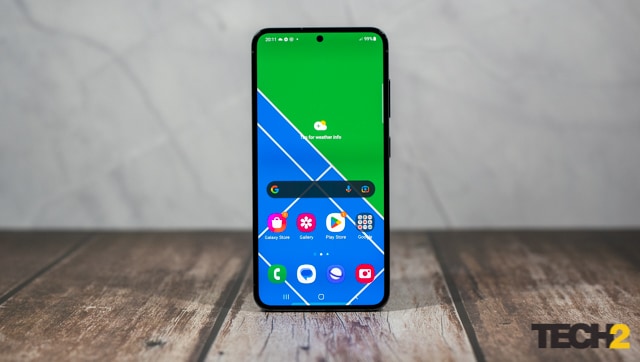
As with the S23 Ultra, the Galaxy S23 will also be getting four generations of OS upgrades for these phones and five years of security upgrades.
Samsung Galaxy S23 review: The battery life
As opposed to the Galaxy S23 Ultra’s 5000mAh battery, the Galaxy S23 comes with a 3900mAh unit, which is an improvement over the last year’s S22. Compared to the S23 Ultra, the battery life is a little, but not by a low, which was a bit surprising for us. The S23 Ultra already has a phenomenal battery life that takes you by surprise. The Galaxy S23 is not far off in that regard as the spec sheet will have you believe.
Without any sort of optimisations, we were getting around 6-7 hours of screen on time with 70 per cent brightness, with about 10 per cent power still left after a 16-hour day, which is surprising given the battery’s capacity. The Galaxy S23 can last you a day, provided you’re willing to make some sacrifices.
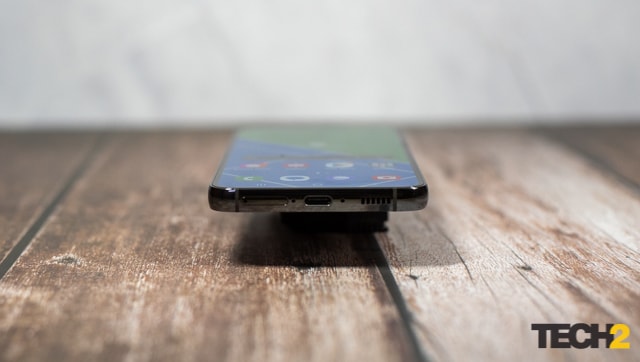
The charging department, however, is where Samsung lets us down. The S23 Plus and the S23 Ultra, both get up to 45W fast wired charging. The Galaxy S23, however, has been kneecapped at 25W wired charging. Plus, the device also does not come with a charging brick, but only with a USB-C to USB-C cable, just like the other two devices in the series. Luckily, the S23 does support fast wireless charging, as well as reverse wired and wireless charging.
Having said that, because the battery is smaller compared to the S23 Ultra, charging it up does not take a long time. We were able to charge our device from zero to a full charge in about 75 minutes or so.
Samsung Galaxy S23 review: The verdict
It is really hard to find a fault with the Galaxy S23, especially when you look at it as an overall package. Our only criticism would be the exclusion of proper fast charging tech for the battery – 25W is just not going to cut it for flagships in this day and age.
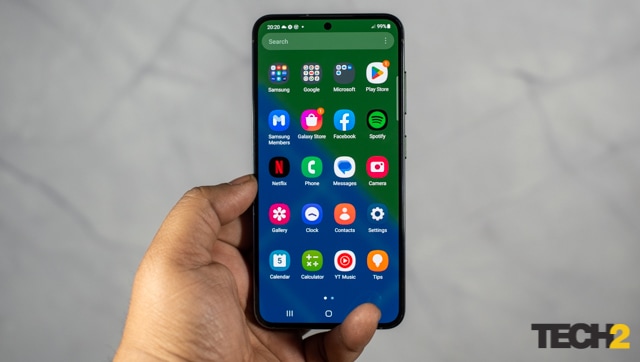
However, everything else that distinguishes a smartphone from a proper flagship smartphone, is been painstakingly perfected. The Samsung Galaxy S23 Ultra is getting all the hype and deservedly so – it is a masterpiece unto itself. However, for most regular people, the regular Galaxy S23 works just fine, if not better.
It’s significantly cheaper, the battery life is almost similar, despite what the spec sheet would make you believe, the speakers are fantastic, the performance is as good as the S23 Ultra, and the display is exquisite. The camera, barring the 200MP sensor and the 100X zoom is as good as the S23 Ultra.
Essentially, if you want to experience what a proper flagship device is capable of but don’t want to spend flagship-like money, get the Galaxy S23 and you’re sorted.
from Firstpost Tech Latest News https://ift.tt/bGNzykp



No comments:
Post a Comment
please do not enter any spam link in the comment box.